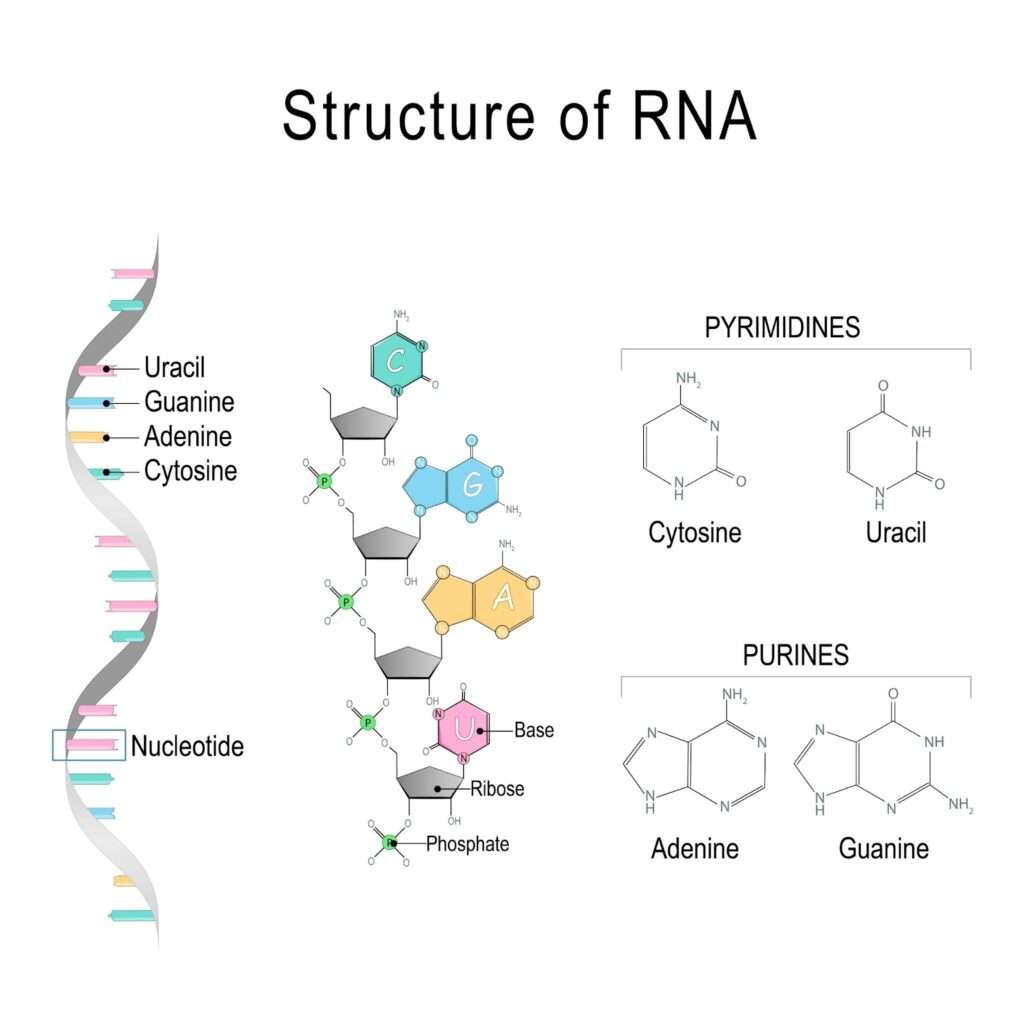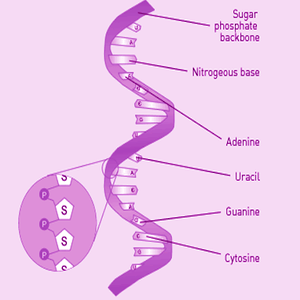Want create site? Find Free WordPress Themes and plugins.
The essential molecule ribonucleic acid, or RNA as it is more generally known, is involved in the transmission of genetic information and the control of several cellular activities. RNA works in the background, directing complex biochemical symphonies within cells, while DNA (deoxyribonucleic acid), which serves as the genetic code for life, frequently takes lead role. We’ll explore RNA’s structure, kinds, uses, and importance in the larger scheme of life as we delve deeply into its universe in this article.
Although RNA and DNA are similar, there are some significant distinctions. First, RNA has a single strand, whereas DNA has two. The sugar ribose is found in RNA, whereas deoxyribose is found in DNA. Third, though DNA has the nitrogenous bases adenine, guanine, cytosine, and thymine, RNA only has adenine, guanine, cytosine, and uracil.
Although RNA and DNA are similar, there are some significant distinctions. First, RNA has a single strand, whereas DNA has two. The sugar ribose is found in RNA, whereas deoxyribose is found in DNA. Third, though DNA has the nitrogenous bases adenine, guanine, cytosine, and thymine, RNA only has adenine, guanine, cytosine, and uracil.
Translation is the process by which RNA is converted into proteins. Ribosomes, which are biological organelles that put together amino acids into proteins, read RNA during translation. The structure of amino acids in a protein is determined by the nucleotide sequence of RNA.
The expression of genes involves RNA additionally. The method by which DNA is converted into RNA and proteins is known as gene expression.
Introduction to RNA



- RNA is found in all living cells, including bacteria, viruses, plants, and animals.
- RNA is a single-stranded molecule, but it can form hairpin loops and other complex structures.
- RNA is much shorter than DNA. The average RNA molecule is about 100 nucleotides long, while the average DNA molecule is about 100 million nucleotides long.
- RNA is more unstable than DNA. This is because it contains the hydroxyl group on the 2′ carbon of the ribose sugar. This group makes RNA more susceptible to hydrolysis, which is the breakdown of RNA molecules by water.
- RNA is essential for protein synthesis. It carries the genetic information from DNA to the ribosomes, where proteins are made.
- RNA is also involved in a number of other cellular processes, such as RNA editing, gene regulation, and RNA interference.
RNA Structure and Types
- Structure of RNA : Nucleotides make up the single-stranded molecule of RNA. A sugar (ribose), a phosphate group, and a nitrogenous base make up a nucleotide. In RNA, nitrogenous bases come in four distinct varieties: adenine (A), guanine (G), cytosine (C), and uracil (U).Phosphodiester bonds form among the sugar on one nucleotide and the phosphate group of the following nucleotide to bind the nucleotides together in RNA. As a result, a long sequence of nucleotides is created, which can either be linear or fold into a complicated shape.



- 2. Types of RNA
- Messenger RNA (mRNA): The ribosomes, which are the building blocks of proteins, get genetic data from DNA via mRNA, a kind of RNA. DNA is translated into mRNA in the cell’s nucleus. DNA & mRNA have sequences of nucleotide that are complementary to one another.
- Transfer RNA (tRNA): The kind of RNA termed tRNA transports amino acids to the ribosomes. An anticodon, or three-nucleotide sequence that is complementary to an mRNA codon, exists in tRNA. As a consequence, tRNA can bind to the mRNA and carry the right amino acid to the ribosome.
- Ribosomal RNA (rRNA): The RNA type that makes up ribosomes is called rRNA. The biological components known as ribosomes put together amino acids to proteins. For the production of proteins, rRNA is required.
RNA's Regulatory Functions
| RNA Type | Regulatory Function |
|---|---|
| Messenger RNA (mRNA) | mRNA can be regulated by a number of factors, including the availability of transcription factors, the presence of RNA-binding proteins, and the structure of the mRNA itself. mRNA regulation can control the amount of protein that is made from a gene. |
| Transfer RNA (tRNA) | tRNA is not typically regulated, as it is needed in relatively constant amounts for protein synthesis. However, there are some cases where tRNA regulation can be important, such as in the case of amino acid starvation. |
| Ribosomal RNA (rRNA) | rRNA is not typically regulated, as it is needed in relatively constant amounts for protein synthesis. However, there are some cases where rRNA regulation can be important, such as in the case of ribosome biogenesis. |
| Small interfering RNA (siRNA) | siRNA is a type of RNA that can be used to silence genes. siRNA is typically produced from longer RNA molecules called pri-siRNAs. Pri-siRNAs are processed by the Dicer enzyme into siRNAs. siRNAs then bind to proteins called Argonaute, which can then silence genes by targeting the mRNA for degradation. |
| MicroRNA (miRNA) | miRNA is a type of RNA that can also be used to silence genes. miRNA is typically produced from longer RNA molecules called pri-miRNAs. Pri-miRNAs are processed by the Drosha enzyme into pre-miRNAs. Pre-miRNAs are then exported to the cytoplasm, where they are further processed by the Dicer enzyme into mature miRNAs. Mature miRNAs then bind to proteins called Argonaute, which can then silence genes by targeting the mRNA for degradation. |
| Circular RNA (circRNA) | circRNA is a type of RNA that is not linear, but rather forms a closed loop. circRNA can be involved in a number of regulatory functions, including gene silencing, RNA editing, and protein translation. |
RNA's Role Beyond Protein Synthesis



In addition to protein production, RNA is involved in a wide range of other biological functions.
- A technique for utilizing RNA to silence genes is called RNA interference (RNAi). Utilizing this, diseases may be treated or gene expression can be controlled.
- RNA molecules called ribozymes are catalysts for chemical reactions. This makes them practical for a range of uses, including medication delivery and gene editing.
- RNA is frequently utilized by viruses as their genetic makeup. They may swiftly adapt and evolve as a result, which makes them challenging to defeat.
- RNA is a messenger that cells utilize to communicate with one another through cell signaling. This is crucial for several activities, including cell development and differentiation.
- Nucleotides in RNA can be changed after transcription through a process called RNA editing. This can be used to alter the protein that the RNA is utilized to encode.
- RNA transport a number of handles are used to move RNA across the cell. This is crucial for several activities, including gene expression and protein synthesis.
- RNA metabolism is continually broken and then recycled inside the cell. This is crucial for regulating gene expression and preserving the integrity of the RNA pool.
RNA World Hypothesis
| Feature | Description |
|---|---|
| Origin | The RNA World hypothesis proposes that life on Earth began with a simple RNA molecule that could copy itself. |
| Self-replication | RNA is capable of self-replication, which means that it can make copies of itself. This is a key property for any molecule that could be considered the basis of life. |
| Catalytic activity | RNA can also act as a catalyst, which means that it can speed up chemical reactions. This is another important property for a living molecule, as it would allow for the efficient production of new RNA molecules. |
| Ribozymes | Ribozymes are RNA molecules that can act as enzymes. This means that they can catalyze specific chemical reactions. Ribozymes are thought to have been important in the early RNA World, as they would have allowed for the first RNA molecules to evolve and become more complex. |
| Evolution to DNA and proteins | Over time, RNA World molecules may have evolved into DNA and proteins. DNA is a more stable molecule than RNA, and it is better suited for storing genetic information. Proteins are more versatile than RNA, and they can perform a wider range of functions. |
| Evidence | There is some evidence to support the RNA World hypothesis. For example, ribosomes, which are the cellular machinery that builds proteins, are composed of RNA. Additionally, some RNA molecules have been found that can act as enzymes. |
| Limitations | The RNA World hypothesis is still a hypothesis, and there is no definitive proof that it is correct. Additionally, there are some challenges that the hypothesis must overcome, such as explaining how RNA molecules could have first arisen and how they could have evolved into DNA and proteins. |
The Future of RNA Research
The study of RNA has the potential to completely alter how we treat illnesses and comprehend the human body. What follows are some of the most fascinating RNA research developments going on right now:
- Development of new RNA-based drugs: A novel family of medications termed RNA-based pharmaceuticals, commonly referred to as RNA therapies, has the potential to treat a variety of illnesses, including cancer, rare disorders, and infectious diseases. By interfering with how RNA molecules operate, RNA therapies have the capacity to halt the synthesis of disease-causing proteins.
- Improved delivery methods for RNA therapeutics: RNA treatments have difficulties delivering RNA molecules to the appropriate body cells. Researchers are at work on novel delivery systems that will make it easier to distribute RNA medicines to their intended sites.
- New insights into RNA biology: RNA is far more adaptable than previously believed. It is involved in a number of biological processes, such as protein synthesis, gene control, and cell signaling. Every day, new discoveries regarding the biology of RNA and its possible applications for treating disease are being made by researchers.
- The development of new RNA-based technologies: In addition, RNA is being utilized to create cutting-edge technologies including RNA vaccinations and RNA diagnostics. RNA vaccinations are a potential new method of disease prevention, and RNA diagnostic can be utilized to detect illnesses more quickly and precisely.
Conclusion
While DNA scripts life’s initial chapters, RNA composes its opus, translating genetic blueprints into tangible existence. Its diverse roles, from genetic messenger to regulatory conductor, underscore RNA’s profound impact on the intricacies of life itself.
FAQs
No, RNA has diverse roles beyond protein synthesis, including gene regulation, catalysis, and genome editing.
While both RNA and DNA are composed of nucleotides, RNA is typically single-stranded and contains uracil instead of thymine.
Yes, RNA-based therapies, such as antisense oligonucleotides and RNA vaccines, show promising potential for treating various diseases.
Epitranscriptomics studies chemical modifications of RNA, shedding light on how these modifications influence RNA’s functions and cellular processes.
Did you find apk for android? You can find new Free Android Games and apps.






